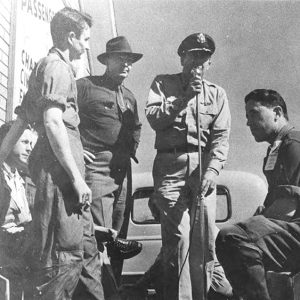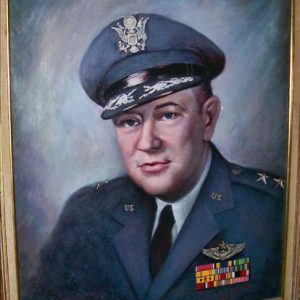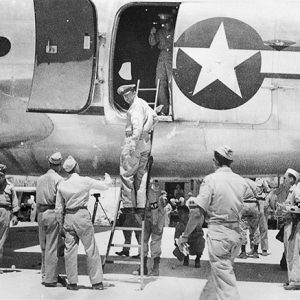calsfoundation@cals.org
Earl Thornton Ricks (1908–1954)
Major General Earl Thornton Ricks served as chief of the Air Force Division, National Guard Bureau, in Washington DC and as mayor of Hot Springs (Garland County), helping end Leo McLaughlin’s political domination there. The Ricks National Guard Armory in Little Rock (Pulaski County) was named for him to commemorate his career, which spanned the most significant years of early aviation history.
Earl Ricks was born on July 9, 1908, in West Point, Mississippi, the only child of Nancy Jordan Ricks and Earl Paul Ricks, an ice plant owner/manager. The family moved to Stamps (Lafayette County) in about 1916. After high school graduation at Stamps, Ricks followed his lifelong interest in flying at Parks Air College in St. Louis, Missouri. After he earned his wings in 1929, his father bought him an airplane—a $375, two-passenger biplane—and he took passengers up, barnstorming style.
In 1930, he married Hazel Brown, daughter of June Hoes Brown and Thomas Addis Brown, a partner in Bodcaw Lumber Company, then the world’s largest lumber company. Ricks and his wife had four children. In 1935, the family moved to Hot Springs, and he partnered with Raymond Clinton in the Ricks-Clinton Buick Company. Two years later, Ricks bought the former home of spa and railroad entrepreneur Samuel Fordyce—a fourteen-room log structure on 478 acres. Still privately owned, it was designated the Fordyce-Ricks Historic District by the National Register of Historic Places in 2003.
In March 1940, Ricks joined the Arkansas National Guard, 154th Observation Squadron. By September, he had entered active army service, transferring later to the Seventeenth Bomb Group. Ricks was quickly recognized as a leader, in 1941 becoming commanding officer of the Thirty-sixth Strategic Air Base in Miami, Florida. The base was the debarkation point for World War II troops to North Africa. Ricks later joined them as commanding officer of Payne Field in Cairo, Egypt.
Ricks was promoted to colonel on April 26, 1944. He became deputy commander, Southwest Pacific Wing, Air Transport Command, based in Australia, New Guinea, and the Philippines. At the end of the Pacific campaign, Ricks piloted the Japanese delegation from Ie Shima to Manila, Philippines, to receive surrender terms from General Douglas MacArthur. Later, Ricks commanded 200 air transports, landing two airborne occupational divisions at Atsugi airdrome, Yokahama, Japan.
Ricks’s keen humor entertained groups, turning even small experiences into adventures. His 6′ 2″, 230-pound frame made it difficult for him to board an airplane, and once he said he never wore a parachute, even in combat, because there would be no way he could exit if the plane were shot down. He personally logged more than 13,000 air miles.
After the war, Ricks returned to Hot Springs, rejoined his automobile agency, and started a charter flying service. Ricks joined a veterans group, led by Sidney McMath, campaigning against a twenty-year-old political machine led by Mayor Leo McLaughlin. This veterans group, known as the “GIs,” outwitted the incumbents and made a clean sweep of the 1946 city elections in what became known as the GI Revolt. Ricks replaced McLaughlin as mayor but eventually chose to serve only one term (1947–1949). While the reform resulted in the loss of three million dollars in general city tax revenue, Ricks declared that Hot Springs was more valuable as a spa city than as a gambling city. Without raising taxes, he was able to improve city infrastructure by reorganizing water, health, and sanitation departments, and developing playgrounds.
In 1948, McMath was elected governor of Arkansas, and Ricks accepted McMath’s appointment as commander of the Arkansas National Guard. On April 21, 1949, he was named brigadier general; by August 1950, he was one of the first state adjutants general.
Major General Ricks received his final promotion on February 27, 1951, becoming chief of the Air Force Division and deputy chief of the National Guard Bureau in Washington DC. His wife moved with him, but his children stayed in Hot Springs. He preferred they be raised and educated in Arkansas.
After a short illness following the removal of a cancerous growth on his leg, Ricks died on January 4, 1954, at Walter Reed Hospital in Washington DC. An unprecedented number of military figures attended his Hot Springs funeral: ten generals and seventy-five to 100 members of the 154th Squadron. Five flights of RF51 fighter jets and B26 bombers paid tribute, and city hall closed. A huge funeral cortege traveled 100 miles to Stamps for his burial. McMath served as a pallbearer.
Ricks received many awards in his lifetime, including the Legion of Merit, the Air Medal, and the Commendation Ribbon. He was inducted posthumously into the Arkansas Aviation Hall of Fame in 1983. The 188th Fighter Wing at Fort Smith (Sebastian County) was dubbed “Ricks Rippers” to honor him, and the Air National Guard Outstanding Airmanship Award is named for him.
For additional information:
Abernathy, Mamie Ruth. “A Salute to Native Sons: Distinguished Men of the Armed Forces.” The Record 25 (1984): 15–17.
“General Earl T. Ricks, Former Mayor Of Hot Springs, Dies.” Hot Springs Sentinel-Record, January 5, 1954, pp. 1, 6.
“High Military Figures Join City in Final Tribute to Gen. Earl Ricks.” Hot Springs New Era, January 7, 1954, pp. 1, 6.
McMath, Sidney S. Promises Kept. Fayetteville: University of Arkansas Press, 2003.
Judy Byrd Brittenum
University of Arkansas, Fayetteville
 Military
Military World War II through the Faubus Era, 1941 through 1967
World War II through the Faubus Era, 1941 through 1967 154th Observation Squadron
154th Observation Squadron  General Ricks Speaking
General Ricks Speaking  Earl Ricks
Earl Ricks  Earl Ricks
Earl Ricks  Earl T. Ricks
Earl T. Ricks 




Comments
No comments on this entry yet.